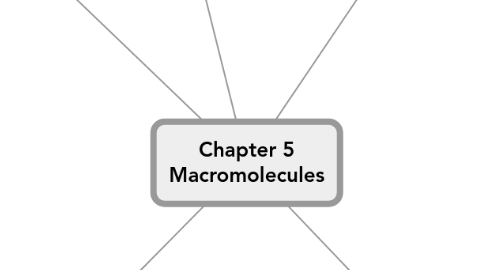
1. lipids
1.1. structure
1.1.1. not based on monomer/polymers
1.1.2. grouped together b/c they are hydrophobic
1.1.3. structure
1.1.3.1. glycerol
1.1.3.2. fatty acids
1.2. types
1.2.1. fat/triglyceride
1.2.1.1. structure
1.2.1.1.1. glycerol molecule
1.2.1.1.2. 3 fatty acid chains
1.2.1.2. function
1.2.2. phospholipid
1.2.2.1. structure
1.2.2.1.1. glycerol "head"
1.2.2.1.2. two fatty acid "tails"
1.2.2.2. function
1.2.3. steroid
1.2.3.1. structure
1.2.3.2. function
1.2.3.2.1. cholesterol
1.2.3.2.2. hormones
2. nucleic acids
2.1. structure
2.1.1. nucleotide
2.1.1.1. sugar
2.1.1.2. nitrogenous base
2.1.1.3. phosphate group
2.1.2. nucleic acid
2.2. function
2.2.1. DNA
2.2.2. RNA
3. assembly
3.1. size
3.1.1. monomers
3.1.1.1. small, simple "pieces"
3.1.1.2. basic "building block"
3.1.2. polymers
3.1.2.1. larger, more complex
3.1.2.2. built out of many monomers joined together
3.2. chemical reactions
3.2.1. condensation rxn
3.2.1.1. bonds two monomers together or a monomer to a polymer
3.2.1.2. forms a water molecule
3.2.2. hydrolysis rxn
3.2.2.1. adds a water to split a chemical bond
3.2.2.2. separates monomers from each other
4. carbohydrates
4.1. monosaccharides
4.1.1. general formula CH2O
4.1.2. function: quick energy
4.1.3. glucose, fructose, ribose
4.2. disaccharides
4.2.1. two monosaccharides joined
4.2.2. maltose = glucose + glucose
4.2.3. sucrose = glucose + fructose
4.3. polysaccharides
4.3.1. multiple monosaccharides
4.3.2. functions
4.3.2.1. energy storage
4.3.2.1.1. animals = glycogen
4.3.2.1.2. plants = starch
4.3.2.2. structural support
4.3.2.2.1. plants = cellulose
4.3.2.2.2. fungi, arthropods = chitin
5. proteins
5.1. structure
5.1.1. amino acid
5.1.1.1. side (R) group
5.1.1.2. central carbon
5.1.1.3. amino group
5.1.1.4. carboxyl group
5.1.2. polypeptide/protein
5.1.2.1. primary structure
5.1.2.1.1. sequence of amino acids
5.1.2.1.2. held together by peptide bonds
5.1.2.2. secondary structure
5.1.2.2.1. alpha-helix, beta-pleated sheet
5.1.2.2.2. held together by H-bonds between amino acids
5.1.2.3. tertiary structure
5.1.2.3.1. folding of one polypeptide into more complex shapes
5.1.2.3.2. caused by interactions between R groups
5.1.2.4. quaternary structure
5.1.2.4.1. association of two or more polypeptide chains into one large protein
5.1.2.4.2. caused by interactions between R groups
5.1.3. importance of structure
5.1.3.1. "lock-and-key" model
5.1.3.2. denaturing
5.2. function
5.2.1. enzymes
5.2.2. structural
5.2.3. storage
5.2.4. transport
5.2.5. hormones
5.2.6. receptor
5.2.7. movement
5.2.8. defensive
